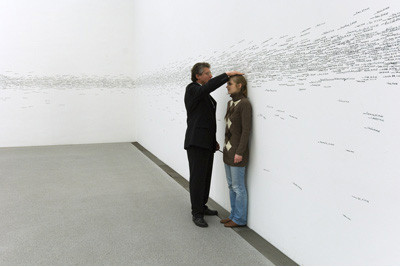Roman Ondák
27 May - 28 Jun 2008

© Roman Ondák
Measuring the Universe, 2007.
For the duration of the exhibition, museum attendants offer to mark the height of visitors on the gallery walls along with their first name and the date. Performance at Pinakothek der Moderne, Munich. Photo: Haydar Koyupinar
Measuring the Universe, 2007.
For the duration of the exhibition, museum attendants offer to mark the height of visitors on the gallery walls along with their first name and the date. Performance at Pinakothek der Moderne, Munich. Photo: Haydar Koyupinar
ROMAN ONDÁK
Passengers: 1.10
May 27–June 28, 2008
For his installations, photographs, drawings, and performances, the Slovakia-based artist Roman Ondák employs the participation of people that he often does not know. Asking them to follow his instructions while also interjecting their own creativity, the result is a controlled study of collective imagination. Common Trip (2000) is a series of drawings and sculptures of places where the artist has traveled, made by people who have never been to these places but to whom the artist has described his memories. To make Passage (2004), Ondák gave chocolate bars to 500 steel factory workers in Kitakyushu, Japan, and asked them to make sculptures from the foil wrappers; the hundreds of tiny artworks were then displayed in an exhibition in Kitakyushu, essentially forming a collective, creative view of the factory. Our City in 3000 (2007), a new work made for this exhibition, is a selection of drawings made by a diverse group of children from across San Francisco. The artist asked each of them to imagine the city in the year 3000 and to make a drawing of the future that included a self-portrait. Suggesting that the future can be glimpsed through the eyes of a younger generation, this work conveys several consistent themes as well as numerous unique and original visions.
Passengers: 1.10
May 27–June 28, 2008
For his installations, photographs, drawings, and performances, the Slovakia-based artist Roman Ondák employs the participation of people that he often does not know. Asking them to follow his instructions while also interjecting their own creativity, the result is a controlled study of collective imagination. Common Trip (2000) is a series of drawings and sculptures of places where the artist has traveled, made by people who have never been to these places but to whom the artist has described his memories. To make Passage (2004), Ondák gave chocolate bars to 500 steel factory workers in Kitakyushu, Japan, and asked them to make sculptures from the foil wrappers; the hundreds of tiny artworks were then displayed in an exhibition in Kitakyushu, essentially forming a collective, creative view of the factory. Our City in 3000 (2007), a new work made for this exhibition, is a selection of drawings made by a diverse group of children from across San Francisco. The artist asked each of them to imagine the city in the year 3000 and to make a drawing of the future that included a self-portrait. Suggesting that the future can be glimpsed through the eyes of a younger generation, this work conveys several consistent themes as well as numerous unique and original visions.
